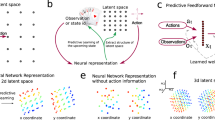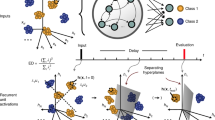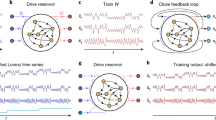Abstract
Learning-to-learn, a progressive speedup of learning while solving a series of similar problems, represents a core process of knowledge acquisition that draws attention in both neuroscience and artificial intelligence. To investigate its underlying brain mechanism, we trained a recurrent neural network model on arbitrary sensorimotor mappings known to depend on the prefrontal cortex. The network displayed an exponential time course of accelerated learning. The neural substrate of a schema emerges within a low-dimensional subspace of population activity; its reuse in new problems facilitates learning by limiting connection weight changes. Our work highlights the weight-driven modifications of the vector field, which determines the population trajectory of a recurrent network and behavior. Such plasticity is especially important for preserving and reusing the learned schema in spite of undesirable changes of the vector field due to the transition to learning a new problem; the accumulated changes across problems account for the learning-to-learn dynamics.
This is a preview of subscription content, access via your institution
Access options
Access Nature and 54 other Nature Portfolio journals
Get Nature+, our best-value online-access subscription
$29.99 / 30 days
cancel any time
Subscribe to this journal
Receive 12 print issues and online access
$209.00 per year
only $17.42 per issue
Buy this article
- Purchase on Springer Link
- Instant access to full article PDF
Prices may be subject to local taxes which are calculated during checkout








Similar content being viewed by others
Data availability
Data files, including pre-trained networks, are available for further analyses on GitHub (https://github.com/xjwanglab/learning-2-learn) in Python and MATLAB readable formats.
Code availability
All training and analysis codes are available on GitHub (https://github.com/xjwanglab/learning-2-learn).
References
Piaget, J. The Language and Thought of the Child (Harcourt Brace, 1926).
Bartlett, F.C. Remembering: A Study in Experimental and Social Psychology (Cambridge University Press, 1932).
Rumelhart, D. E. Schemata: the building blocks of cognition. in Theoretical Issues in Reading Comprehension 33–58 (Erlbaum Associates, 1980).
Gilboa, A. & Marlatte, H. Neurobiology of schemas and schema-mediated memory. Trends Cogn. Sci. 21, 618–631 (2017).
Chi, M. T., Glaser, R. & Rees, E. Expertise in problem solving. https://www.public.asu.edu/~mtchi/papers/ChiGlaserRees.pdf (1982).
Harlow, H. F. The formation of learning sets. Psychological Review 56, 51–65 (1949).
Lewis, P. A. & Durrant, S. J. Overlapping memory replay during sleep builds cognitive schemata. Trends Cogn. Sci. 15, 343–351 (2011).
Behrens, T. E. J. et al. What is a cognitive map? Organizing knowledge for flexible behavior. Neuron 100, 490–509 (2018).
Preston, A. R. & Eichenbaum, H. Interplay of hippocampus and prefrontal cortex in memory. Curr. Biol. 23, R764–R773. (2013).
Wang, S.-H. & Morris, R. G. Hippocampal–neocortical interactions in memory formation, consolidation, and reconsolidation. Annu. Rev. Psychol. 61, 49–79 (2010).
McKenzie, S. et al. Hippocampal representation of related and opposing memories develop within distinct, hierarchically organized neural schemas. Neuron 83, 202–215 (2014).
Bernardi, S. et al. The geometry of abstraction in the hippocampus and prefrontal cortex. Cell 183, 954–967 (2020).
Braun, D. A., Mehring, C. & Wolpert, D. M. Structure learning in action. Behav. Brain Res. 206, 157–165 (2010).
Finn, C., Abbeel, P. & Levine, S. Model-agnostic meta-learning for fast adaptation of deep networks. In Proceedings of the 34th International Conference on Machine Learning 1126–1135 (PMLR, 2017).
Wang, J. X. et al. Prefrontal cortex as a meta-reinforcement learning system. Nat. Neurosci. 21, 860–868 (2018).
Passingham, R. The Frontal Lobes and Voluntary Action (Oxford University Press, 1995).
Asaad, W. F., Rainer, G. & Miller, E. K. Neural activity in the primate prefrontal cortex during associative learning. Neuron 21, 1399–1407 (1998).
Fusi, S., Asaad, W. F., Miller, E. K. & Wang, X.-J. A neural circuit model of flexible sensorimotor mapping: learning and forgetting on multiple timescales. Neuron 54, 319–333 (2007).
Cromer, J. A., Machon, M. & Miller, E. K. Rapid association learning in the primate prefrontal cortex in the absence of behavioral reversals. J. Cogn. Neurosci. 23, 1823–1828 (2011).
Bussey, T. J., Wise, S. P. & Murray, E. A. Interaction of ventral and orbital prefrontal cortex with inferotemporal cortex in conditional visuomotor learning. Behav. Neurosci. 116, 703–715 (2002).
Petrides, M. Deficits on conditional associative-learning tasks after frontal- and temporal-lobe lesions in man. Neuropsychologia 23, 601–614 (1985).
Stringer, C. et al. Spontaneous behaviors drive multidimensional, brainwide activity. Science 364, 255 (2019).
Zhou, J. et al. Evolving schema representations in orbitofrontal ensembles during learning. Nature 590, 606–611 (2021).
Sadtler, P. T. et al. Neural constraints on learning. Nature 512, 423–426 (2014).
Bao, P., She, L., McGill, M. & Tsao, D. Y. A map of object space in primate inferotemporal cortex. Nature 583, 103–108 (2020).
Eacott, M. & Gaffan, D. Inferotemporal–frontal disconnection: the uncinate fascicle and visual associative learning in monkeys. Eur. J. Neurosci. 4, 1320–1332 (1992).
Kobak, D. et al. Demixed principal component analysis of neural population data. eLife 5, e10989 (2016).
Anderson, R. C., Spiro, R. J. & Anderson, M. C. Schemata as scaffolding for the representation of information in connected discourse. Am. Educ. Res. J. 15, 433–440 (1978).
Rumelhart, D. E. & Norman, D. A. Accretion, tuning and restructuring: three modes of learning. https://www.dsoergel.com/UBLIS571DS-06.1a-1Reading10RumelhartAccretionTuningAndRestructuring.pdf (1978).
Thorndyke, P. W. & Hayes-Roth, B. The use of schemata in the acquisition and transfer of knowledge. Cogn. Psychol. 11, 82–106 (1979).
Kaufman, M. T., Churchland, M. M., Ryu, S. I. & Shenoy, K. V. Cortical activity in the null space: permitting preparation without movement. Nat. Neurosci. 17, 440–448 (2014).
Strogatz, S. H. Nonlinear Dynamics and Chaos: With Applications to Physics, Biology, Chemistry and Engineering 2nd edn (Taylor & Francis, 2016).
Vyas, S., Golub, M. D., Sussillo, D. & Shenoy, K. V. Computation through neural population dynamics. Annu. Rev. Neurosci. 43, 249–275 (2020).
Long, P. M. & Sedghi, H. Generalization bounds for deep convolutional neural networks. In International Conference on Learning Representations (ICLR, 2020).
Gouk, H., Hospedales, T. M. & Pontil, M. Distance-based regularisation of deep networks for fine-tuning. In International Conference on Learning Representations (ICLR, 2021).
Kaufman, M. T. et al. The largest response component in the motor cortex reflects movement timing but not movement type. eNeuro 3, ENEURO.0085-16.2016 (2016).
Tenenbaum, J. B., Kemp, C., Griffiths, T. L. & Goodman, N. D. How to grow a mind: statistics, structure, and abstraction. Science 331, 1279–1285 (2011).
Sussillo, D. & Barak, O. Opening the black box: low-dimensional dynamics in high-dimensional recurrent neural networks. Neural Comput. 25, 626–649 (2013).
Dubreuil, A., Valente, A., Beiran, M., Mastrogiuseppe, F. & Ostojic, S. The role of population structure in computations through neural dynamics. Nat. Neurosci. 25, 783–794 (2022).
Wang, S.-H., Tse, D. & Morris, R. G. Anterior cingulate cortex in schema assimilation and expression. Learn. Mem. 19, 315–318 (2012).
Sehgal, M., Song, C., Ehlers, V. L. & Moyer, J. R. Jr. Learning to learn—intrinsic plasticity as a metaplasticity mechanism for memory formation. Neurobiol. Learn. Mem. 105, 186–199 (2013).
Bittner, K. C., Milstein, A. D., Grienberger, C., Romani, S. & Magee, J. C. Behavioral time scale synaptic plasticity underlies CA1 place fields. Science 357, 1033–1036 (2017).
Wang, X.-J. Probabilistic decision making by slow reverberation in cortical circuits. Neuron 36, 955–968 (2002).
Kingma, D. P. & Ba, J. Adam: a method for stochastic optimization. In International Conference on Learning Representations (ICLR, 2015).
Abadi, M. et al. TensorFlow: a system for large-scale machine learning. USENIX Symposium on Operating Systems Design and Implementation 16, 265–283 (2016).
Stewart, G. W. The efficient generation of random orthogonal matrices with an application to condition estimators. SIAM J. Numer. Anal. 17, 403–409 (1980).
Krogh, A. & Hertz, J. A. A simple weight decay can improve generalization. In Advances in Neural Information Processing Systems 950–957 (NeurIPS, 1991).
Merity, S., McCann, B. & Socher, R. Revisiting activation regularization for language RNNs. In International Conference on Machine Learning’s Workshop on Learning to Generate Natural Language (ICML, 2017).
Gao, P. et al. A theory of multineuronal dimensionality, dynamics and measurement. Preprint at https://www.biorxiv.org/content/10.1101/214262v2 (2017).
Acknowledgements
We thank A. L. Fairhall, I. Skelin, J. J. Lin, B. Doiron, G. R. Yang, N. Y. Masse, U. P. Obilinovic, L. Y. Tian, D. V. Buonomano, J. Jaramillo, J. E. Fitzgerald and H. Sompolinksy for fruitful discussions and Y. Liu, K. Berlemont, A. Battista and P. Theodoni for critical comments on the manuscript. This work was supported by National Institute of Health U-19 program grant 5U19NS107609-03 and Office of Naval Research grant N00014-23-1-2040.
Author information
Authors and Affiliations
Contributions
B.P., D.J.F., E.A.B. and X.-J.W. designed the study. V.G. performed the research. V.G. and X.-J.W. wrote the manuscript.
Corresponding author
Ethics declarations
Competing interests
The authors declare no competing interests.
Peer review
Peer review information
Nature Neuroscience thanks the anonymous reviewers for their contribution to the peer review of this work.
Additional information
Publisher’s note Springer Nature remains neutral with regard to jurisdictional claims in published maps and institutional affiliations.
Supplementary information
Supplementary Information
Supplementary Notes, Supplementary Methods, Supplementary Discussion and Supplementary Figs. 1–10.
Rights and permissions
Springer Nature or its licensor (e.g. a society or other partner) holds exclusive rights to this article under a publishing agreement with the author(s) or other rightsholder(s); author self-archiving of the accepted manuscript version of this article is solely governed by the terms of such publishing agreement and applicable law.
About this article
Cite this article
Goudar, V., Peysakhovich, B., Freedman, D.J. et al. Schema formation in a neural population subspace underlies learning-to-learn in flexible sensorimotor problem-solving. Nat Neurosci 26, 879–890 (2023). https://doi.org/10.1038/s41593-023-01293-9
Received:
Accepted:
Published:
Issue Date:
DOI: https://doi.org/10.1038/s41593-023-01293-9
This article is cited by
-
Reconstructing computational system dynamics from neural data with recurrent neural networks
Nature Reviews Neuroscience (2023)



